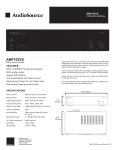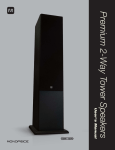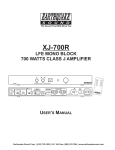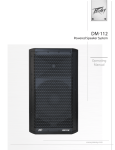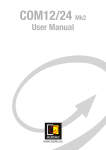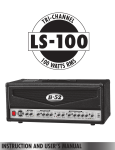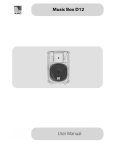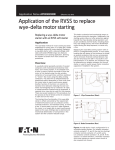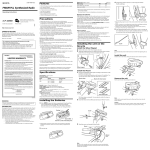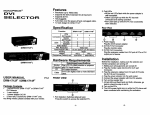Download User`s manual
Transcript
TABLE OF CONTENTS SAFETY WARNINGS AND GUIDELINES ...................................................................... 3 INTRODUCTION ............................................................................................................. 5 FEATURES ..................................................................................................................... 5 CUSTOMER SERVICE ................................................................................................... 5 PACKAGE CONTENTS .................................................................................................. 5 PRODUCT OVERVIEW .................................................................................................. 6 INPUT VOLTAGE AND FUSE SELECTION ................................................................... 7 SPEAKER BREAK-IN ..................................................................................................... 8 SPEAKER PLACEMENT ................................................................................................ 8 CONNECTING THE SUBWOOFER................................................................................ 9 Connecting to a Dedicated Subwoofer Output ............................................................. 9 Connecting to a Stereo Preamplifier Output ................................................................ 9 Connecting to a Stereo Speaker Output .................................................................... 10 SUBWOOFER SETTINGS ............................................................................................ 11 TROUBLESHOOTING .................................................................................................. 12 TECHNICAL SUPPORT................................................................................................ 12 SPECIFICATIONS ........................................................................................................ 13 REGULATORY COMPLIANCE ..................................................................................... 14 2 SAFETY WARNINGS AND GUIDELINES Please read this entire manual before use, paying extra attention to these safety warnings and guidelines. Please keep this manual in a safe place for future reference. • This device is intended for indoor use only. • Do not expose this device to water or moisture of any kind. Do not place drinks or other containers with moisture on or near the device. If moisture does get in or on the device, immediately unplug it from the power outlet. • If operating this speaker in a humid environment, ensure that no condensation occurs. Condensation could cause damage to the speaker cone and could cause a short in the subwoofer's amplifier, which in turn could cause fire or severe electric shock. • Use only in a well-ventilated area. Do not use in close, confined spaces. • Do not expose this device to excessively high temperatures. Do not place it in, on, or near heat sources, such as a fireplace, stove, radiator, etc. Do not leave it in direct sunlight. • The power supply for this subwoofer uses a NEMA 5-15 three prong, grounded plug. Do not use a "cheater" plug or otherwise bypass the grounding pin. • Disconnect the unit from the power source when replacing the fuse. Replace the fuse only with the same type or an exact equivalent. • Unplug this device from the power source when not in use. • Prior to operation, check the unit and power cord for physical damage. Do not use if physical damage has occurred. • Before plugging the unit into a power outlet, ensure that the outlet provides the same type and level of power required by the device, as determined by the Voltage Selection switch on the rear panel. • Do not allow the power cord to be crimped, pinched, stepped on, etc. Ensure that the power cord does not present a tripping hazard. • Ensure that power is turned off and disconnected before making any electrical connections. • When disconnecting the power cord, do not pull on the cord itself. Instead, grasp the plug connector head to disconnect it from the power socket. • Do not bypass the purpose of the fuse by shorting the contacts or by any other means. If the fuse blows or breaks, replace it with the type specified for your mains voltage in the Specifications section of this manual. • Clean only using a soft, dry cloth. Do not use chemical cleaners, solvents, or detergents. For stubborn deposits, moisten the cloth with warm water. 3 • This device has no user serviceable parts. Do not attempt to open, service, or modify this device. • Do not pick up or carry the subwoofer by grasping the ports on the front. • When picking up the subwoofer, take care not to touch the exposed speaker cone on the front of the unit. • Double-check all connections prior to applying power to ensure that speaker polarity is properly matched and that there are no stray wire strands, which could short the connections, either on the back of the speaker or the receiver/amplifier. • Do not use full volume until after the subwoofer has been fully broken-in. • If you hear distortion, reduce the volume until the distortion is no longer audible. Distortion can sound like a buzzing, scratching, or hammering sound. Distortion can damage or destroy delicate speaker coils. • To avoid annoying feedback, ensure that any turntable is isolated from the vibrations produced by this subwoofer. • Extreme volume in the bass frequencies can distort the image on a nearby television. If this occurs, move the subwoofer further away from the TV. 4 INTRODUCTION Thank you for purchasing this Premium Home Theater 250-watt Powered Subwoofer from Monoprice! This subwoofer is designed to integrate with an existing audio system. It accepts inputs from a dedicated subwoofer output, from stereo pre-amplifier outputs, or from stereo high (speaker) level outputs, making it compatible with almost any amplifier or AV receiver. FEATURES • Built-in 250-watt power amplifier • 12" paper cone speaker with rubber surround • Phase switch with 0° and 180° settings • Auto-on/auto-standby function saves power • Dedicated LFE subwoofer input • Stereo low-level (pre-amplifier) RCA inputs • Stereo high-level (speaker wire) inputs • 5-way binding posts accept bare wire, pin plugs, banana plugs, and terminal lugs • Switchable 110/220 VAC input power CUSTOMER SERVICE The Monoprice Customer Service department is dedicated to ensuring that your ordering, purchasing, and delivery experience is second to none. If you have any problem with your order, please give us an opportunity to make it right. You can contact a Monoprice Customer Service representative through the Live Chat link on our website (www.monoprice.com) during normal business hours (Mon-Fri: 5am-7pm PT, Sat-Sun: 9am-6pm PT) or via email at [email protected] PACKAGE CONTENTS After receiving the product, please inventory the contents to ensure you have all the proper parts, as listed below. If anything is missing or damaged, please contact Monoprice Customer Service for a replacement. 1x Powered subwoofer 1x AC power cord (NEMA 5-15 to IEC 60320 C13) 1x User's manual 5 PRODUCT OVERVIEW 1. AC Power Socket and Fuse Holder: Uses an AC power cable with an IEC 60320 C13 plug. The fuse is a T4AL/250V (or 5S4A/250V or equivalent) 4 amp slow-blow fuse for 110V operation and a T2AL/250V (or equivalent) 2 amp slowblow fuse for 220V operation. A spare 4 amp fuse is stored in the fuse holder. 2. Main Power Switch: Depress the side of the switch with the • mark to apply power to the subwoofer. 3. Voltage Selector Switch: Selects 110-120VAC or 220-240VAC operation. 4. Auto Power Switch: When set to the ON position, the subwoofer will remain fully powered on whenever the Main Power Switch is set to the ON position. When set to the AUTO position, the subwoofer will remain in standby mode until audio material is detected, at which point it will automatically turn on, and then will go back into standby mode after several minutes of inactivity. When set to the OFF position, the subwoofer will remain in standby mode whenever the Main Power Switch is set to the ON position, regardless of the presence of audio material or not. 5. Phase Switch: Determines whether the subwoofer's driver is moving in phase with the main speaker drivers or not. Depending on the location of your subwoofer, it may need to be 180° out of phase with the main speakers. Leave this switch in whichever position produces the best sound. 6 6. Frequency Knob: Adjusts the crossover frequency from 40 ~ 200 Hz, for audio input from either the Low Level or High Level inputs. 7. Volume Knob: Adjusts the volume level of the subwoofer relative to other speakers in the system. The overall volume level will increase or decrease, depending on the volume setting on the amplifier. 8. Low Level Inputs: This RCA stereo input is designed for use with the stereo pre-amplifier output on an amplifier/AV receiver. 9. LFE Input: The Low Frequency Effects input is designed for use with a dedicated, monophonic subwoofer output on an amplifier/AV receiver. This input bypasses the crossover circuit so that the subwoofer can reproduce all the bass frequencies produced by the amp. Refer to your amplifier's user's manual for instructions on setting up and using the LFE output. 10. High Level Inputs: These inputs are designed to accept a signal from the amplified speaker-wire output terminals on an amplifier/AV receiver. INPUT VOLTAGE AND FUSE SELECTION Prior to making any connections, check the input voltage selector on the rear panel. By default, the subwoofer ships with the voltage selector in the 110-120V position and with a T4AL/250V fuse installed in the fuse holder. If you will be plugging this subwoofer into a 220-240 VAC power source, perform the following steps: 1. Use a small, flat-blade screwdriver to remove the fuse holder from the combination power socket/fuse holder. 2. Replace the default T4AL/250V (or 5S4A/250V) fuse with a T2AL/250V fuse of the same size/dimensions. 3. Reinsert the removable portion of the fuse holder into the combination power socket/fuse holder. 4. Using a #1 Phillips screwdriver, remove the two screws holding the plastic cover over the Voltage Selector switch. Remove the plastic cover. 5. Slide the Voltage Selector switch from the 110-120V position to the 220-240V position. 6. Reposition the plastic cover over the Voltage Selector switch and secure it in place using the two screws removed in step 4. If you have been using the subwoofer in a 220-240VAC environment and are moving it to a 110-120VAC environment, perform the above steps, except that the replacement fuse should be the T4AL size and the Voltage Selector switch should be placed in the 110-120V position. 7 SPEAKER BREAK-IN In the same way that a new car requires a break-in period before it can be safely operated at high engine RPMs, speakers require a break-in period before they can be safely operated at maximum volume levels. Proper break-in ensures that the moving parts of the speaker (the cone and cone suspension) are allowed to flex and soften, losing the initial stiffness and allowing the speaker to move through its full intended range. After the break-in period, the speakers will produce richer and fatter sounding lows, warmer and smoother sounding mids, and cleaner and more accurate highs, without any hint of distortion. The best way to break-in speakers is simply to play normal music or watch movies at moderate volume levels. The amount of time required for speaker break-in varies based on the operating environment, but is typically in the area of 50~80 hours. It will take a bit longer in a cold or dry environment and a little less time in a warm or humid environment. Note that the break-in period does not have to be continuous. SPEAKER PLACEMENT Before making any connections, you should examine your listening room and decide where you will place the subwoofer. Some basic "rules of thumb" for the proper placement of a subwoofer are: • Do not place the subwoofer in a corner, as it will result in a "boomy", unnatural sounding bass. • Do not place the subwoofer directly against a wall or cabinet. There should be some room around the subwoofer for the sound to develop and reflect itself around the room. • Although bass is omnidirectional, a location in the front center is generally ideal. Tip: One good way to determine the best initial location for the subwoofer is to first place it at your ideal listening location. While playing music with solid bass content, walk around the room until the bass sounds best, then move the subwoofer to that location and fine tune from there. Using the above guidelines, plan the location for the subwoofer. This should be considered an initial location, to be adjusted based on listening tests in the ideal listening location, after the subwoofer has been broken-in. The placement is particularly dependent on experimentation and listening tests. If possible, do not make any permanent installation choices until after you have had a chance to listen to the subwoofer in the proposed positions and have made any fine tuning adjustments necessary to produce the best sound. Real world speaker placement is an exercise in compromise between the ideal and the realistic, with your ears as the final arbiter. 8 CONNECTING THE SUBWOOFER Warning! To prevent possible personal injury and/or damage to your equipment, turn off and unplug all equipment before making connections! This subwoofer offers three types of connections, making it compatible with almost any amplifier or AV receiver. The available connection types are, in order of quality: • Using a single digital coaxial RCA cable to connect the LFE Input on the subwoofer to a dedicated subwoofer output on an amplifier/AV receiver • Using two RCA cables (or a single stereo RCA cable) to connect the Low Level Inputs on the subwoofer to stereo preamplifier outputs on an amplifier/AV receiver • Using two speaker wires to connect the High Level Inputs on the subwoofer to stereo speaker terminals on an amplifier/AV receiver Connecting to a Dedicated Subwoofer Output A dedicated subwoofer output is usually a single RCA jack marked "Subwoofer", "Sub Pre Out", or something similar on the back of the amplifier/AV receiver. Refer to the manufacturer's documentation for reference. Subwoofer outputs are monophonic, so if you have two subwoofer outputs they are intended to drive two separate subwoofers. To make this connection you will need a cable with a single RCA plug on each end (not included). 1. Insert the RCA plug at the one end of the cable into the LFE Input jack on the back of the subwoofer. 2. Insert the RCA plug at the other end of the cable into the subwoofer output jack on the back of the amplifier/AV receiver. Connecting to a Stereo Preamplifier Output If your amplifier/receiver lacks a dedicated line level subwoofer output, the next best option for connecting the subwoofer is to use preamplifier outputs. These outputs should not be confused with line level outputs intended to connect components, such as tape decks or DVD recorders, to the amp. Preamplifier outputs will usually be marked as "Pre-amp Out" or something similar. Refer to your amplifier's user's manual to determine which, if any, outputs are the pre-amp outputs. To make this connection you will need a stereo RCA patch cable of the appropriate length (not included). 1. Insert the white/left side of one end of the cable into the white/left Low Level Input RCA jack on the back of the subwoofer. 9 2. Insert the red/right side of one end of the cable into the red/right Low Level Input RCA jack on the back of the subwoofer. 3. Insert the white/left side of the other end of the cable into the white/left preamplifier output RCA jack on the back of the amplifier/AV receiver. 4. Insert the red/right side of the other end of the cable into the red/right preamplifier output RCA jack on the back of the amplifier/AV receiver. Connecting to a Stereo Speaker Output If your amplifier lacks either a dedicated subwoofer output or pre-amplifier outputs, you can still make a connection using speaker level inputs on the subwoofer. To make this connection, you will need two equal lengths of two-conductor speaker wire (not included). For best results, use the thickest gauge speaker wire possible. The 5way binding posts can accept speaker wire up to 5 AWG (5mm diameter), which means that the size of the speaker wire is likely limited by the capabilities of the amplifier's speaker terminals. Please refer to your amplifier's user's manual to determine the thickest gauge speaker wire it will accept. Note that making bare speaker wire connections is less than ideal. Using banana or pin plugs is highly recommended for several reasons: plugs are easier to connect, they don't run the risk of stray wire strands shorting the connections, they allow for use of heavier gauge speaker wire in most cases, and it is much easier to identify the polarity from a color coded ring on a plug then from a subtle marking along the length of a wire. 1. Connect the black/negative side of one speaker wire to the black/negative left channel terminal on the back of the subwoofer. 2. Connect the red/positive side of the wire to the red/positive left channel spring loaded terminal on the back of the subwoofer. 3. Connect the black/negative side of the other end of the speaker wire to the black/negative left channel output for the Front/Main speakers on the back of the amp. This can be connected in parallel to the actual front main speakers. 4. Connect the red/positive side of that end of the wire to the red/positive left channel output for the Front/Main speakers on the back of the amp. 5. Repeat steps 1-4 for the right channel connection. 6. Visually inspect the connections at each end to verify correct polarity and the absence of any stray wire strands. 10 SUBWOOFER SETTINGS Auto Power: In addition to the main power switch, the subwoofer features an Auto Power switch, which determines the power behavior of the subwoofer. When the switch is set to the AUTO position, the subwoofer will automatically power on when it detects an audio signal and, after several minutes of inactivity, will automatically go into standby mode. When the switch is set to the ON position the subwoofer will remained powered on at all times and, when the switch is set to the OFF position, the subwoofer will remain in standby mode, regardless of the presence of audio signals. Note: If you will be away, or if the subwoofer will go unused for a lengthy period, set the main power switch to the OFF position. Frequency: The frequency knob sets the frequency for the low-pass filter, which determines how well the bass from the subwoofer blends with the other speakers in the system. Set the frequency to the lower frequency limit of your main speakers and then adjust it up or down as needed until it sounds best. Volume: The overall volume of the subwoofer will increase or decrease with the volume of the other speakers. The volume control on the subwoofer is therefore used to match the audio output level of the main speakers so that they blend into a single, smooth, continuous sound. In general, unless your musical material is particularly bass-heavy or bass-light, once you have set the volume on the subwoofer you shouldn't need to adjust it again. Phase: Depending on the location of your subwoofer, the sound that reaches your ideal listening location could be out of phase with the sound from the rest of the system. If the bass sounds out of timing, muddy, or attenuated, try flipping the phase switch to the other position. The default, which will provide the best bass sound most of the time, is with the phase set to 0°. As the subwoofer breaks in, you may find you need to make minor adjustments to the low-pass filter and volume level settings to ensure the proper blend between the speakers. 11 TROUBLESHOOTING Q1: The subwoofer is plugged in and the power switch is in the ON position, but the power LED on the rear panel remains off. A1: Check to verify that the power outlet is live by plugging a different device into it. Try using a different power cord of the same type (NEMA 5-15 to IEC 60320 C13). Check the fuse to verify it is not blown. Q2: The power LED glows red, but no sound is coming from the subwoofer. A2: Verify that audio material is being played. Check the cable connections from the amplifier to the subwoofer. Check the subwoofer's AUTO switch to verify it is in the AUTO or ON position. Q3: The audio from the subwoofer is thin, tinny, out of timing, or otherwise does not sound like it should. A3: Try flipping the Phase switch to the other position. Try repositioning the subwoofer relative to your listening position. Ensure that the subwoofer is not placed directly against a wall or cabinet and is not in a corner. Try adjusting the Frequency and volume settings to produce a smoother blend with the other speakers in the system. TECHNICAL SUPPORT Monoprice is pleased to provide free, live, online technical support to assist you with any questions you may have about installation, setup, troubleshooting, or product recommendations. If you ever need assistance with your new product, please come online to talk to one of our friendly and knowledgeable Tech Support Associates. Technical support is available through the online chat button on our website (www.monoprice.com) during regular business hours, 7 days a week. You can also get assistance through email by sending a message to [email protected] 12 SPECIFICATIONS Speaker Type Bass reflex with dual front-firing ports Driver 12" paper cone with rubber surround Frequency Response 30 ~ 150 Hz, -10dB Variable Low-Pass Filter 40 ~ 200 Hz @ 18dB/octave Variable Phase Control 0° or 180° Amplifier Power Output 250 watts THD ≤ 0.5% Inputs Monophonic LFE, stereo Low Level (pre-amplifier), and stereo High Level (speaker wire) Fuse Type T4AL/250V or 5S4A/250V (110-120V) T2AL/250V (220-240V) 13 REGULATORY COMPLIANCE FCC Class B Notice Note: This equipment has been tested and found to comply with the limits for a Class B digital device, pursuant to Part 15 of the FCC Rules. These limits are designed to provide reasonable protection against harmful interference in a residential installation. This equipment generates, uses and can radiate radio frequency energy and, if not installed and used in accordance with the instructions, may cause harmful interference to radio communications. However, there is no guarantee that interference will not occur in a particular installation. If this equipment does cause harmful interference to radio or television reception, which can be determined by turning the equipment off and on, the user is encouraged to try to correct the interference by one or more of the following measures: • Reorient or relocate the receiving antenna. • Increase the separation between the equipment and receiver. • Connect the equipment into an outlet on a circuit different from that to which the receiver is connected. • Consult the dealer or an experienced radio/television technician for help. Modifications: Any modifications made to this device that are not approved by Monoprice, Inc. may void the authority granted to the user by the FCC to operate this equipment. This product is in compliance with CE directives and bears the CE mark. For detailed information on specific directives, please contact Monoprice Customer Service. This symbol on the product or on its packaging indicates that the product must not be disposed of with normal household waste. Instead, it is your responsibility to dispose of your waste equipment by arranging to return it to a designated collection point for the recycling of waste electrical and electronic equipment. By separating and recycling your waste equipment at the time of disposal, you will help to conserve natural resources and ensure that the equipment is recycled in a manner that products human health and the environment. 14















